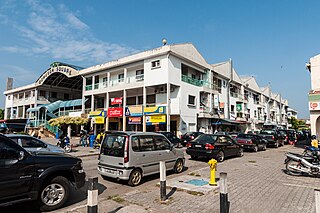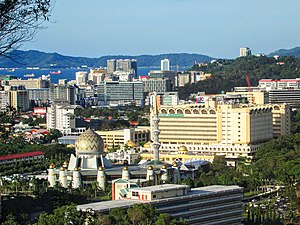
Kota Kinabalu, colloquially referred to as KK, is the state capital of Sabah, Malaysia. It is also the capital of the Kota Kinabalu District as well as the West Coast Division of Sabah. The city is located on the northwest coast of Borneo facing the South China Sea. The Tunku Abdul Rahman National Park lies to its west and Mount Kinabalu, which gave the city its name, is located to its east. Kota Kinabalu has a population of 452,058 according to the 2010 census; when the adjacent Penampang and Tuaran districts are included, the metro area has a combined population of 628,725. The 2020 Census revealed an increase in the municipal population to 500,421, while the wider area including the Penampang and Putatan districts had a population of 731,406.

West Coast Division is an administrative division of Sabah, Malaysia. It occupies the northwest portion of Sabah. With an area of 7,588 square kilometres, it occupies 10.3% of Sabah's territory. It also has approximately 30% of Sabah's total population, with the main indigenous inhabitants comprising the Bajau, Bisaya, Bruneian Malay, Dusun, Illanun, Kadazan and Kedayan, as well with a significant numbers of Chinese. The division is divided into the districts of Ranau, Kota Belud, Tuaran, Penampang, Papar, and the state capital Kota Kinabalu. The main towns are as in the names of the districts, plus other towns including Putatan, Inanam, Telipok, Tamparuli, Tenghilan and Kinarut.

Penampang is the capital of the Penampang District in the West Coast Division of Sabah, Malaysia. Its population was estimated to be around 93,616 in 2010, with ethnic Kadazan as the majority. It contains, or is synonymous with, Donggongon, which as of 2007, it has a population of 78,086.

Kadazan-Dusun are the largest ethnic group in Sabah, Malaysia, an amalgamation of the closely related indigenous Kadazan and Dusun peoples. They are also known as Mamasok Sabah, meaning "indigenous people of Sabah". Kadazan-Dusun tradition holds that they are the descendants of Nunuk Ragang. Kadazan-Dusun is recognised as an indigenous nation of Borneo with documented heritage by the United Nations Educational, Scientific and Cultural Organization (UNESCO) since 2004. Kadazan-Dusun is part of bumiputera group in Malaysia and has special rights concerning land, rivers, education and maintaining their own customs.

Sabah State Railway is a railway system and operator in the state of Sabah in Malaysia. It is the only rail transport system operating on the island of Borneo. The railway consists of a single 134-kilometre line from Tanjung Aru, Kota Kinabalu in West Coast Division to the town of Tenom, in the Interior Division. It was formerly known as North Borneo Railway.

Putatan is a municipality in the capital of the Putatan district in the West Coast Division of Sabah, Malaysia. Its population was estimated to be around 100,000 in 2021. It is one of the satellite town of Kota Kinabalu metropolitan area together with neighbouring Petagas town. Putatan railway station is one of the stops for Sabah State Railway while INTI College Sabah Campus became the main campus for Kota Kinabalu in Putatan town.

Lok Kawi is a township in the West Coast Division of Sabah, Malaysia. Located around the border of the districts of Penampang and Papar, and about 15 kilometres south of the state capital Kota Kinabalu, it has become part of the urban expanse of Kota Kinabalu. Nearby towns include Putatan in the north, and Kinarut in the south.

The Roman Catholic Archdiocese of Kota Kinabalu is a metropolitan archdiocese of the Latin Church of the Roman Catholic Church in Sabah, a state of Malaysia on the island of Borneo. The archdiocese is the oldest ecclesiastical territory in Malaysia, with a long history slowly rising along with the Catholic population from a prefecture to an archdiocese. Its cathedral archepiscopal see is Sacred Heart Cathedral, Kota Kinabalu. The patron saint of the archdiocese is St. Joseph, Spouse of the Blessed Virgin Mary.
Servay Hypermarket (S) Sdn. Bhd. is a hypermarket and retailer chain in Malaysia. It is one of the main existing retailer in East Malaysia, having over 30 branches spread throughout Sabah and Sarawak. It was founded by Dato Sri Lai Kock Poh in 1990.

Putatan is a federal constituency in West Coast Division, Sabah, Malaysia, that has been represented in the Dewan Rakyat since 2004.

Tun Pengiran Haji Ahmad Raffae bin Orang Kaya Pengiran Haji Omar was the second Governor of the Malaysian state of Sabah.

The Kota Belud District is an administrative district in the Malaysian state of Sabah, part of the West Coast Division which includes the districts of Kota Belud, Kota Kinabalu, Papar, Penampang, Putatan, Ranau and Tuaran. The capital of the district is in Kota Belud Town.

The Kota Kinabalu District is an administrative district in the Malaysian state of Sabah, part of the West Coast Division which includes the districts of Kota Belud, Kota Kinabalu, Papar, Penampang, Ranau and Tuaran. The capital of the district is in Kota Kinabalu City.

The Papar District is an administrative district in the Malaysian state of Sabah, part of the West Coast Division which includes the districts of Kota Belud, Kota Kinabalu, Papar, Penampang, Putatan, Ranau and Tuaran. The capital of the district is in Papar Town.

The Penampang District is an administrative district in the Malaysian state of Sabah, part of the West Coast Division which includes the districts of Kota Belud, Kota Kinabalu, Papar, Penampang, Putatan, Ranau and Tuaran. The capital of the district is in Penampang Town.

The Putatan district is an administrative district in the Malaysian state of Sabah, part of the West Coast Division which includes the districts of Kota Belud, Kota Kinabalu, Papar, Penampang, Ranau and Tuaran. The capital of the district is in Putatan Town.

The Tuaran District is an administrative district in the Malaysian state of Sabah, part of the West Coast Division which includes the districts of Kota Belud, Kota Kinabalu, Papar, Penampang, Putatan, Ranau and Tuaran. The capital of the district is in Tuaran Town.
The local government in Sabah is the lowest level government in Sabah, Malaysia. It ranks third in the Malaysian government system after federal and state government. Local governments have the power to levy property taxes, to enact local laws and regulations, and to issue licenses and permits for any type of trade in their area. However, it also has the obligation to provide basic utilities, such as to regulate rubbish collection and waste disposal and to ensure urban or regional planning.






















